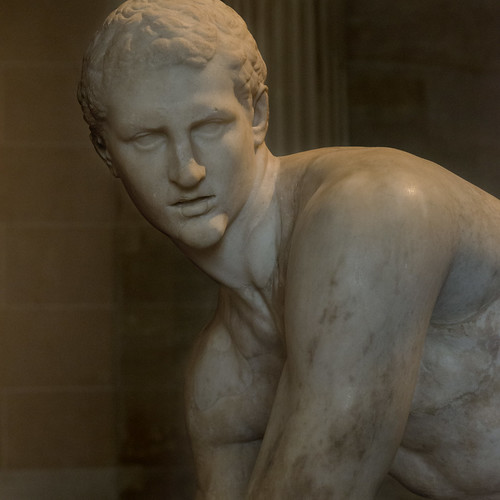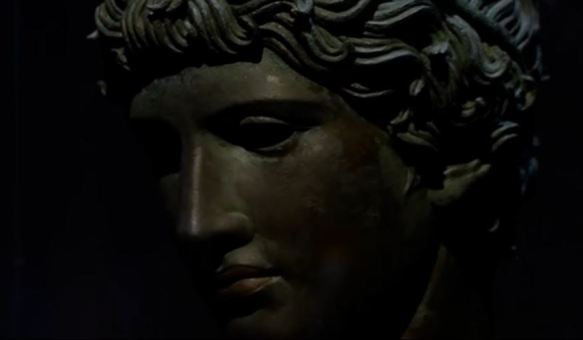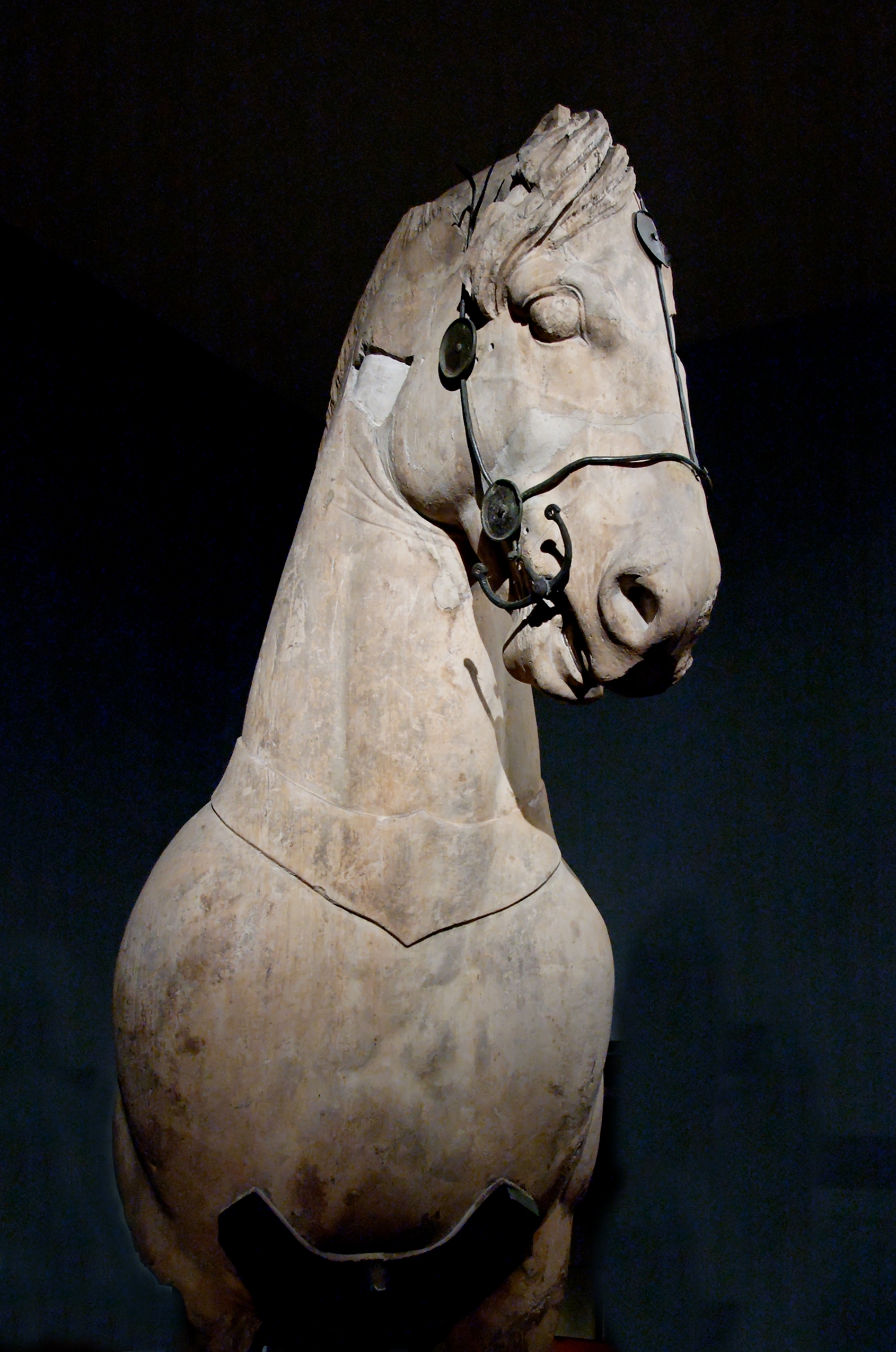Head of Apollo, First century BCE–first century CE, bronze, 51 x 40 x 38 cm. Salerno, Museo Archeologico Provinciale.
By Alain.R.Truong
FLORENCE.- From 14 March to 21 June 2015, Palazzo Strozzi in Florence will be the first venue to host the major exhibition entitled Power and Pathos. Bronze Sculpture of the Hellenistic World organised and produced in conjunction with the J. Paul Getty Museum in Los Angeles, the National Gallery of Art in Washington and the Soprintendenza Archeologica della Toscana, Tuscany’s directorate general for archaeology. After Florence, the exhibition will travel to the J. Paul Getty Museum in Los Angeles from 28 July to 1 November 2015 and then to the National Gallery of Art in Washington, DC, from 6 December 2015 to 20 March 2016.

Statue Base signed by Lysippos, End of fourth–beginning of third century BCE, blue-grey limestone, 30 x 70.5 x 70,5 cm. Corinth, 37th Ephorate of Prehistoric and Classical Antiquities.
This important joint venture reinforces Palazzo Strozzi’s international reputation for excellence. The exhibition will showcase – for the first time in Florence – some of the greatest masterpieces of the ancient world from such leading Italian and international museums as the Museo Archeologico Nazionale in Florence, the Museo Nacional del Prado in Madrid, the Museo Archeologico Nazionale in Naples, the British Museum in London, the Metropolitan Museum of Art in New York, the Galleria degli Uffizi in Florence, the National Archaeological Museum of Athens, the Archaeological Museum of Heraklion (Crete), the Kunsthistorisches Museum in Vienna, the Archaeological Museum of Thessaloniki, the Musée du Louvre in Paris, the Vatican Museums and the Musei Capitolini in Rome.

Portrait Statue of Aule Meteli (Arringatore), Late second century BCE, bronze, 179 cm. Florence, Museo Archeologico Nazionale.
Power and Pathos features about 50 extraordinary sculptures in bronze and tells the story of the artistic achievements of the Hellenistic era (4th to 1st centuries BC), when new bronze-working techniques were developed, new forms of expression were explored, and a first globalized language of art emerged in the Mediterranean and beyond. In this cosmopolitan climate, Greek art, in effect, became an international phenomenon.

Statuette of Alexander the Great on Horseback, First century BCE, bronze, with silver inlays, 49 x 47 x 29 cm. Naples, Museo Archeologico Nazionale.
The vast Hellenistic empire founded by Alexander the Great stretched from Greece and the borders of Ethiopia to the Indus Valley, embracing Egypt, Persia, and Mesopotamia. Thus its astonishing output in the fields of art, history and philosophy enjoyed extensive dissemination. While the Classical Greek world was based essentially on the polis, or citystate, now art served more than the cities and their citizens and focused instead on the courts of Alexander’s successors. Artists devoted their skills to celebrating the rulers and their achievements, adopting and adapting Classical modes of expression to suit new needs.

Horse Head (“Medici Riccardi” Horse), Second half of the fourth century BCE, bronze, 81 x 95 x 40 cm. Florence, Museo Archeologico Nazionale.
The exhibition owes its unique character to bronze, an alloy of copper, tin, and often lead, so significant in ancient technology and art that Pliny the Elder dedicated an entire book to this medium. Bronze works are extremely rare today, and the vast majority of large bronzes from the ancient world are lost because they have been melted down over the centuries so that the metal could be used to mint coins and to manufacture arms. Immediately after casting, bronze was so dazzling that it resembled gold.

Head of a Man with Kausia, Third century BCE, bronze, faïence or alabaster, 32 x 27.9 cm. Pothia, Archaeological Museum of Kalymnos.
One of the reasons this show is an unprecedented, once-in-a-lifetime event is that it will allow visitors to admire works never before seen together: the bronze Apoxyomenos from Vienna alongside the Uffizi’s marble version used in its restoration; the two archaising Apollo-Kouroi from the Louvre and from Pompeii. Although all of these “pairs” have frequently been shown together in photographs, this is the very first time that any of them have been displayed side by side. A large number of the bronzes surviving to this day were found in the sea rather than on dry land. Spectacular underwater finds include the figure of a General (Lucius Aemilius Paullus?) found in the sea off Brindisi in 1992, and the Head of a Man with Kausia (discovered in the Aegean off the island of Kalymnos in 1997).

Portrait of a Diadoch (Demetrios Poliorketes?), 310–290 BCE, bronze, 45 x 35 x 39 cm. Madrid, Museo Nacional del Prado.
The discovery of the head of Apollo in the sea off Salerno in December 1930 was poetically described by Nobel Prize laureate Giuseppe Ungaretti: “Night had almost fallen and the anchovy fishermen were returning to port in single file. Gathering up their nets, one of the fishermen found […] a head of Apollo in his net. Holding it up in the palm of his lined hand and seeing it now imbued with new life in the light and appearing to bleed – where it had been severed at the neck – in the fire of the setting sun, the fisherman thought he was looking at St. John the Baptist. I myself have seen it at the Museum in Salerno; it may be by Praxiteles or possibly Hellenistic […] its indulgent and quivering smile hinting at an ineffable song of youth restored to life!”

Portrait of Arsinoë III, Late third century–early second century BCE, bronze, 30 x 20 x 30 cm. Mantua, Museo Civico di Palazzo Te.
Unlike Classical artists, who sought to convey a sense of balance and serenity, Hellenistic sculptors aimed to capture the full range of human feelings, from anger and passion to joy and anguish. They typically emphasised pathos, or lived experience, in the figures they depicted, and we find this also in the portraits of the men who rose to power in Alexander’s wake. Such portraits were designed to bolster the sitters’ legitimacy and dynastic connections through a combination of individual features both dramatic and idealised. Statues of athletes such as the so-called Apoxyomenos—a figure shown after the competition, holding a small curved instrument called a strigil used to scrape off sweat and dirt from the body— focus on the nude male body in its various forms. Artists no longer represent wholly idealised forms, as in the Classical era, but depict momentary details that vividly express physical and emotional states.

Statue of a Man, Second century BCE, bronze, 127 x 75 x 49 cm h. 30 cm (head). Brindisi, Museo Archeologico Provinciale “F. Ribezzo”.
Curated by Jens Daehner and Kenneth Lapatin of the J. Paul Getty Museum in Los Angeles, the exhibition offers a comprehensive overview of the Hellenistic bronze sculpture in its larger archaeological, cultural and geographical environments.

Portrait of a Man, First century BCE, bronze, 29.5 x 21.5 x 21.5 cm. Malibu, J. Paul Getty Museum.
Monumental statues of gods, athletes, and heroes will be displayed alongside portraits of historical figures—including select sculptures in marble and stone—in a journey allowing visitors to explore the fascinating stories of these masterpieces’ discovery, often at sea (Mediterranean, Black Sea) but also in the course of archaeological digs, thus setting the finds in their ancient contexts. Those contexts could be a sanctuary where they were used for votive purposes, a public space where they celebrated personalities or events, a home where they fulfilled a decorative function, or a cemetery where they commemorated the deceased. A unique feature of the Palazzo Strozzi exhibition is that it sets the works in context by also probing and exploring the production and casting processes and the finishing techniques adopted.

Statuette of a Ruler as Hermes or Perseus, First century BCE–first century CE, bronze, with base 80 x 30 x 25.4 cm. Naples, Museo Archeologico Nazionale.

Statue of a Young Man, Third–fourth century BCE, bronze, 152 x 52 x 68 cm. Athens, Ephorate of Underwater Antiquities.

Statuette of Hermes, c. 150 BCE, bronze, 49 x 20 x 15 cm. London, The British Museum.

Statuette of the Weary Herakles, Third century BCE or first century CE (?); copy of a fourth-century BCE bronze by Lysippos, bronze, silver, 35.9 x 17.5 x 14 cm h. 39 cm with base. Chieti, Museo Archeologico Nazionale d’Abruzzo.

Statuette of an Artisan, Mid-first century BCE, bronze, silver, 40.03 x 13 x 10.8 cm. New York, The Metropolitan Museum of Art.

Statuette of Herakles Epitrapezios (Herakles seated), First century BCE–first century CE, bronze, limestone, 75 x 67 x 54 cm h. 95 cm with base. Naples, Museo Archeologico Nazionale.

Statue of Eros Sleeping, Third–second century BCE, bronze, 41.9 x 85.2 x 35.6 cm. New York, The Metropolitan Museum of Art.

Portrait of a Man, End of second–beginning of first century BCE, bronze, glass paste, black stone, 32.5 x 22 x 22 cm. Athens, National Archaeological Museum.

Portrait of a Bearded Man, c. 150 BCE, marble, 40.7 x 25 x 31.7 cm. Malibu, J. Paul Getty Museum.

Head of a Votive Statue, 375–350 BCE, bronze, 24.3 x 15.5 x 15.5 cm.London, The British Museum.

Portrait of a Man, Late fourth–third century BCE, bronze, copper, glass paste, 26.8 x 21.8 x 23.5 cm. Paris, Bibliothèque nationale de France.

Portrait Statue of a Young Ephebe, First half of the first century BCE, bronze, with base 140 x 57.2 x 45.1 cm. Heraklion, Archaeological Museum.

Portrait Statue of an Aristocratic Boy, Augustan period (27 BCE–14 CE), bronze, 132.4 x 50.8 x 41.9 cm. New York, The Metropolitan Museum of Art.

Portrait of a Man, First century BCE, bronze, 43 x 26 x 25 cm. Naples, Museo Archeologico Nazionale.

Bust of a Man (Lucius Calpurnius Piso Caesoninus Pontifex), Late first century BCE–early first century CE, 46 x 28 x 23 cm. Naples, Museo Archeologico Nazionale.

Portrait of a Man, 50–25 BCE, bronze, copper, marble, 32 x 22 x 22 cm h. 22.5 cm (head). Copenaghen, Ny Carlsberg Glyptotek.

Statue of an Athlete (Apoxyomenos from Ephesos), 1–50 CE, bronze, 205.4 x 78.7 x 77.5 cm. Vienna, Kunsthistorisches Museum.

Head of an Athlete (Ephesos Apoxyomenos type), Second century BCE–first century CE, bronze, 29.2 x 21 x 27.3 cm h. 51.4 cm with base. Fort Worth, Kimbell Art Museum.

Statue of an Athlete (Ephesos Apoxyomenos type), Second century CE, marble, h. 193 cm. Florence, Galleria degli Uffizi.

Torso of an Athlete (Ephesos Apoxyomenos type), First century CE, basanite, h. 110 cm. Castelgandolfo, Musei Vaticani, Villa Pontificia, Antiquarium.

Herm of Dionysos (Getty Herm), Workshop of Boëthos of Kalchedon (attributed), Second century BCE, bronze, copper, calcitic stone, 103.5 x 23.5 x 19.5 cm. Malibu, J. Paul Getty Museum.

Athena (Minerva of Arezzo), 300–270 BCE, bronze, copper, 155 x 50 x 50 cm. Florence, Museo Archeologico Nazionale.

Medallion with the Bust of Athena, c. 150 BCE, bronze, white glass paste, 27.2 x 27.1 x 19 cm. Thessaloniki, Archaeological Museum.

Head of Aphrodite (?), First century BCE, bronze, 37x 30.5 x 29 cm. London, The British Museum.

Statue of Apollo (Piombino Apollo), 120–100 BCE, bronze, copper, silver, 117 x 42 x 42 cm. Paris, Musée du Louvre.

Statue of Apollo (Kouros), First century BCE–first century CE, bronze, copper, bone, dark stone, glass, 128 x 33 x 38 cm. Pompeii, Soprintendenza Speciale per i Beni Archeologici di Pompei, Ercolano e Stabia.

Torso of a Youth (The Vani Torso), Second century BCE, bronze, 105 x 45 x 25 cm. Tbilisi, Georgian National Museum.

Herm Bust of the Doryphoros, Apollonios (active late first century BCE), Late first century BCE, bronze, 58 x 66 x 27 cm. Naples, Museo Archeologico Nazionale.

Ephebe (Idolino from Pesaro), c. 30 BCE, bronze, copper, lead, h. 148 cm h. 300 cm with base. Florence, Museo Archeologico Nazionale.

Bust of an Ephebe (Beneventum Head), c. 50 BCE, bronze, copper, 33 x 23 x 20 cm. Paris, Musée du Louvre.

Spinario (Spinario Castellani), c. 25–50 CE, marble, cm 69 x 40,5 x 35. London, The British Museum.
https://francescarachelvalle.wordpress.com/2015/03/15/firenze-potere-e-pathos-bronzi/
http://alaintruong.canalblog.com/archives/2015/03/14/31700771.html
http://www.giacobbegiusti.com

















































































